How Cool Roofs Stack Up
A low-cost white roof covering produced an average rooftop temperature drop of 43 degrees F. over black roofs in New York City last summer, according to research by the city and Columbia University scientists.
The three-year field study compared the performance and durability of typical black roofs to three dominant white membrane options for flat roofs in the U.S. – EPDM rubber, TPO, and an asphaltic multi-ply built-up roof coated with white elastomeric acrylic paint.
The subsequent findings revealed that all maintained effective temperature control and met the ENERGY STAR Cool Roof performance standards, which require a three-year aged albedo above 0.50.
This indicates that widespread use of the three studied materials could reduce a city’s vulnerability to the urban heat island effect, which is caused by the higher solar energy absorption of common urban landscape materials like asphalt, metal, and dark-colored buildings.
However, considerable performance differences among the cool roofs raise other questions. Findings on the white membranes’ aging process included:
The EPDM membrane offered low thermal emissivity and thus avoided any winter heat penalty, meaning that it maintained slightly warmer temperatures during winter than the black membrane did. Researchers hypothesized that this was due to an even lower field emissivity on the white membrane that the manufacturer did not recognize.
The painted asphaltic surface showed high thermal emissivity and lost about half of its initial albedo (solar reflectance) within two years. However, the building’s location next to a busy urban thoroughfare, its susceptibility to rainwater ponding, and wear and tear to the granulated asphalt surface may have contributed to darkening, which would reduce the paint’s albedo. This study marked the first time the city used the paint as part of a major urban albedo enhancement program.
The white TPO maintained relatively stable temperature performance and albedo over the three-year study, though the temperature gap between the two narrowed as weather faded the black surface used as a control on the same project.
The white roof surfaces were installed as part of NYC CoolRoofs, an aspect of of Mayor Michael Bloomberg’s drive to lower the Big Apple’s greenhouse gas emissions 30% by 2030.
